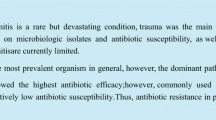Abstract
Trichosporon asahii is a rare but emerging fungal pathogen that causes severe and life-threatening infections with high mortality rate, mostly in immunocompromised patients. It could be easily misdiagnosed due to lack of awareness, especially when invasive or deep-seated infections occur in non-immunocompromised patients, and inadequately treated since the clinical failures and high minimum inhibitory concentrations to some antifungal agents have been described. We present a case of T. asahii catheter-related infection in 66-year-old comatose patient with polytrauma, who was not immunodeficient, but was receiving broad-spectrum antibiotics for a long period. Due to prompt diagnosis and treatment which included catheter replacement and voriconazole, the patient successfully recovered from this infection. The aims of this case report were to highlight the importance of recognizing this otherwise colonizing yeast as potentially dangerous pathogen in non-immunocompromised patients with a long-term antibiotic therapy, and to emphasize the importance of the right therapeutic choice due to its resistance to certain antifungal agents.
Similar content being viewed by others
References
Haupt HM, Merz WG, Beschorner WE, Vaughan WP, Saral R. Colonization and infection with Trichosporon species in the immunosuppressed host. J Infect Dis. 1983;147:199–203.
Chagas-Neto TC, Chaves GM, Columbo AL. Update on genus Trichosporon. Mycopathologia. 2008;166(3):121–32.
Gueho E, Improvisi L, de Hoog GS, Dupont B. Trichosporon on humans: a practical account. Mycoses. 1994;37:3–10.
Netsvyetayeva I, Swoboda-Kopec E, Paczek L, Fiedor P, Sikora M, Jaworska-Zaremba M, Blachnio S, Luczak M. Trichosporon asahii as a prospective pathogen in solid organ transplant recipients. Mycoses. 2009;52:263–5.
Dua V, Yadav SP, Oberoi J, Sachdeva A. Successful treatment of Trichosporon asahii infection with voriconazole after bone marrow transplant. J Pediatr Hematol Oncol. 2013;35(3):237–8.
Ozkaya-Parlakay A, Karadag-Oncel E, Cengiz AB, Kara A, Yigit A, Gucer S, Gur D. Trichosporon asahii sepsis in a patient with pediatric malignancy. J Microbiol Immunol Infect. 2013 Feb 15. pii: S1684-1182(13)00018-2. doi:10.1016/j.jmii.2013.01.003.
Isenberg HD. Catheter Tip Cultures, in: Clinical Microbiology Procedures Handbook. 2nd edition. Washington, DC: American Society for Microbiology, 2007; 3.6.1–3.6.6.
Ebright JR, Fairfax MR, Vazquez JA. Trichosporon asahii, a non-Candida yeast that caused fatal septic shock in a patient without cancer or neutropenia. Clin Infect Dis. 2001;33(5):E28–30.
Di Bonaventura G, Pompilio A, Picciani C, Iezzi M, D’Antonio D, Piccolomini R. Biofilm formation by the emerging fungal pathogen Trichosporon asahii: development, architecture, and antifungal resistance. Antimicrob Agents Chemother. 2006;50(10):3269–76.
Sun W, Su J, Xu S, Yan D. Trichosporon asahii causing nosocomial urinary tract infections in intensive care unit patients: genotypes, virulence factors and antifungal susceptibility testing. J Med Microbiol. 2012;61:1750–7.
Clancy CJ, Nquyen MH. Finding the “missing 50 %” of invasive candidiasis: how nonculture diagnostics will improve understanding of disease spectrum and transform patient care. Clin Infect Dis. 2013;56(9):1284–92.
Rastogi VL, Nirwan PS. Invasive trichosporonosis due to Trichosporon asahii in a non-immunocompromised host: a rare case report. Indian J Med Microbiol. 2007;25(1):59–61.
Kim YJ, Kim SI, Kim YR, Park YM, Park YJ, Kang MW. Successful treatment of septic shock with purpura fulminans caused by Trichosporon asahii in an immunocompetent patient. Ann Clin Lab Sci. 2007;37(4):366–9.
Suzuki K, Nakase K, Kyo T, Kohara T, Sugawara Y, Shibazaki T, Oka K, Tsukada T, Katayama N. Fatal Trichosporon fungemia in patients with hematologic malignancies. Eur J Haematol. 2010;84(5):441–7.
Shang ST, Yang YS, Peng MY. Nosocomial Trichosporon asahii fungemia in a patient with secondary hemochromatosis: a rare case report. J Microbiol Immunol Infect. 2010;43(1):77–80.
Girmenia C, Pagano L, Martino B, D’Antonio D, Fanci R, Specchia G, Melillo L, Buelli M, Pizzarelli G, Venditti M, Martino P. GIMEMA Infection Program. Invasive infections caused by Trichosporon species and Geotrichum capitatum in patients with hematological malignancies: a retrospective multicenter study from Italy and review of the literature. J Clin Microbiol. 2005;43(4):1818–28.
Wolf DG, Falk R, Hacham M, Theelen B, Boekhout T, Scorzetti G, Shapiro M, Block C, Salkin IF, Polacheck I. Multidrug-resistant Trichosporon asahii infection of nongranulocytopenic patients in three intensive care units. J Clin Microbiol. 2001;39(12):4420–5.
Asada N, Uryu H, Koseki M, Takeuchi M, Komatsu M, Matsue K. Successful treatment of breakthrough Trichosporon asahii fungemia with voriconazole in a patient with acute myeloid leukemia. Clin Infect Dis. 2006;43:e39–41.
Matsue K, Uryu H, Koseki M, Asada N, Takeuchi M. Breakthrough trichosporonosis in patients with hematologic malignancies receiving micafungin. Clin Infect Dis. 2006;42:753–7.
Rodriguez-Tudela JL, Diaz-Guerra TM, Mellado E, Cano V, Tapia C, Perkins A, Gomez-Lopez A, Rodero L, Cuenca-Estrella M. Susceptibility patterns and molecular identification of Trichosporon species. Antimicrob Agents Chemother. 2005;49:4026–34.
Bayramoglu G, Sonmez M, Tosun I, Aydin K, Aydin F. Breakthrough Trichosporon asahii fungemia in neutropenic patient with acute leukemia while receiving caspofungin. Infection. 2008;36:68–70.
ESCMID EFISG study group and ECMM. ESCMID and ECMM joint clinical guidelines for the diagnosis and management of rare invasive yeast infections. Clin Microbiol Infect. 2014;20(Suppl 3):76–98.
Acknowledgments
We thank Dr. Emilija Mlinaric-Missoni from Referral Center for Systemic Mycoses in Croatian Institute of Public Health, Zagreb, for the generous assistance.
Conflict of interest
On behalf of all authors, the corresponding author states that there is no conflict of interest.
Author information
Authors and Affiliations
Corresponding author
Rights and permissions
About this article
Cite this article
Rubic, Z., Novak, A., Tomic, Z. et al. Prompt Diagnosis and Effective Treatment of Trichosporon asahii Catheter-Related Infection in Non-immunocompromised Neurosurgical Patient. Mycopathologia 179, 125–128 (2015). https://doi.org/10.1007/s11046-014-9814-9
Received:
Accepted:
Published:
Issue Date:
DOI: https://doi.org/10.1007/s11046-014-9814-9




